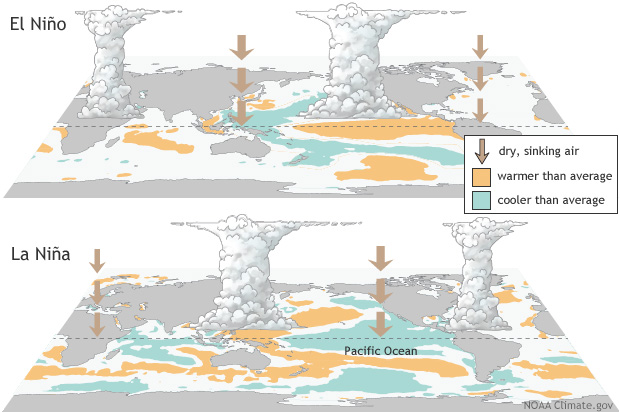I’ve mentioned Rossby (planetary) waves in a number of
posts. With each passing mention the realization grew in me that I need to
explain—or attempt an explanation—of this very important global phenomenon.
Every time you look at a weather map and see the jet stream snaking across
Canada and the northern United States, you’re looking at Rossby waves rhythmically
perturbing the air flow. They’re a complicated topic but I’ll give it a shot!
(This will be another longer-than-usual post. But that’s okay because yesterday’s
was really short. :P ).
Rossby waves, also known as planetary waves, are large-scale
north-south fluctuations in the atmosphere and ocean. Their amplitude can be
hundreds of miles, and one wavelength can be over a thousand. Waves are
disturbances in a continuum—sound waves in the air, wind-driven waves on the
ocean surface—where a restoring force acts to correct the disturbance. But the
restoring force overcorrects, and pushes the medium in the opposite direction,
creating the back-and-forth fluctuation. In sound waves, the restoring force is
pressure—whether of air, water, or a solid (solids transmit sounds!). In
wind-driven ocean waves, the restoring force is gravity. In Rossby waves, the restoring
force is (effectively) the Coriolis
effect.
Schematic of a northern-hemisphere Rossby wave.
The Coriolis effect is a function of the vorticity within a
fluid. Vorticity is, simply put, a measure of the angular momentum—the spin—at a
given point in a fluid. Earth being a rotating sphere, vorticity varies from
zero at the equator to its maximum value at the poles. Let’s assume some ocean
water at a given latitude—50°N, for example—happened to be pushed
to the north. The water moving to the north has negative vorticity—that is, less
angular momentum—less spin--than the water around it. This negative vorticity manifests
as the water from farther south being diverted to the right, in a clockwise
motion. This continual diversion to the
right results in the water moving back to the south.
Likewise, if water from 50°N were pushed to the south, it
would have greater vorticity (spin) than the more southerly water, resulting in
its being diverted to the left, counterclockwise. The result is a wavelike motion, where water
carried to the north or south, usually due to a pressure imbalance, begins to
move in a curved path back toward its original latitude. Momentum then carries
the parcel of water past its original latitude—into overshoot--and so the north-to-south
wave motion is created.
Jet stream Rossby wave fluctuations.
This process is not limited to ocean water in the northern
hemisphere. The same thing happens in the southern hemisphere: water moving
south is diverted counterclockwise to the left, and water moving to the north is diverted clockwise to the right, again setting up the north-to-south Rossby wave motion. These waves
occur in the atmosphere as well—in fact they’re named after the Swedish meteorologist,
Carl-Gustaf Rossby, who discovered them.
The group velocity—how quickly the peaks and crests move—of a
Rossby wave is slow. Atmospheric Rossby waves might take several weeks to
travel across North America, while oceanic Rossby waves take months to cross a
basin. Faster planetary waves have a westward group velocity, where the peaks
and crests move to the west; slower wave crests travel to the east.
Meteorology, oceanography and even astrophysics share fluid
dynamics. The same equations, with different numbers for variables like mass,
velocity, and viscosity, are used to describe liquids, gases, and plasma. The
rotational dynamics of the surface of the Sun and the outer layer of Jupiter
are modeled in exactly the same way we do our own atmosphere.
As an aside: Carl’s son Tom was one of my grad school
advisors. You’re not likely to find a gentler, kinder man. His Christmas glög
parties were legendary, but he stopped throwing them because they lasted till
dawn and he got too tired. Tom categorically refused to use the term “Rossby
wave”—he insisted on the term planetary. He was modest enough to tell the story
of how he flunked his first oral doctorate exam, but also loved tossing in a
question on every final that had nothing whatsoever to do with his lectures—just
to “see how we’d handle it.” He happens to be one of the most celebrated ocean
researchers of the 20th century and is responsible for a good deal of our
understanding of mid-ocean-depth dynamics.
Tomorrow: the North Atlantic Oscillation.
Be brave, and be well.










































